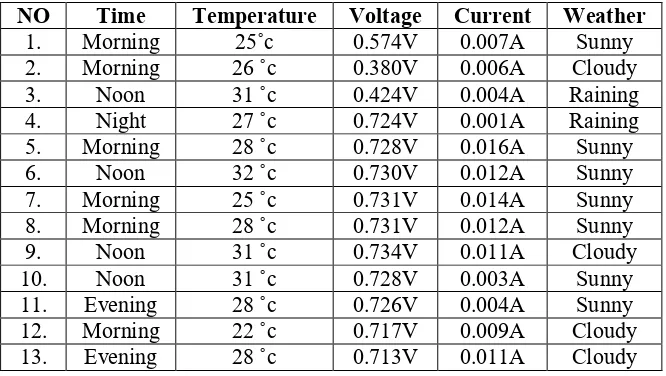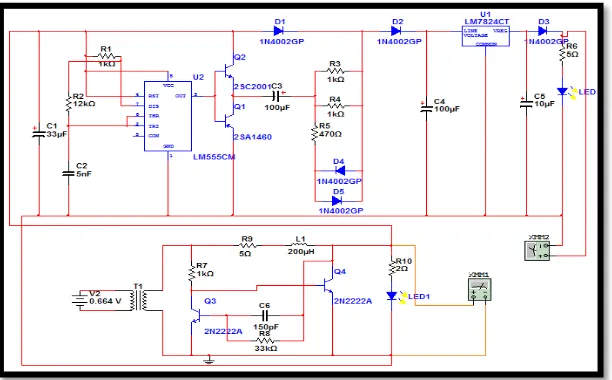Journal of Physics: Conference Series
PAPER • OPEN ACCESS
Lighting system design using green energy from
living plants
To cite this article: M.F. Lee et al 2018 J. Phys.: Conf. Ser. 1019 012019
View the article online for updates and enhancements.
Related content
Trainer of Traffic Light System Based on PLC
K Kurniati and Y Mulyadi
-Naïve Bayes Approach for Expert System Design of Children Skin Identification Based on Android
Hartatik, A Purnomo, R Hartono et al.
-Scenarios reducing greenhouse gas emission from motor vehicles in State University of Malang
I W Agustin and C Meidiana
1234567890 ‘’“”
1st International Conference on Green and Sustainable Computing (ICoGeS) 2017 IOP Publishing IOP Conf. Series: Journal of Physics: Conf. Series 1019 (2018) 012019 doi :10.1088/1742-6596/1019/1/012019
Lighting system design using green energy from living plants
M.F. Lee1, M.N.N. Mohd Zain2 and C.S. Lai3
1,2,3Faculty of Technical & Vocational Education, Universiti Tun Hussein Onn
Malaysia, 86400 Parit Raja, Batu Pahat, Johor
mflee@uthm.edu.my, nnaimzain@gmail.com, lcsern@uthm.edu.my
Abstract. Green energy is the energy generated from nature such as water, wind, solar and wave that aimed to reduce environmental damage or destruction, sustain the use of energy and natural resources as well as promote the use of renewable energy. This study aimed to analyse the electrical energy generated by the three types of living plants selected at the parking area of the Faculty of Technical and Vocational Education and design a lighting system for the parking area by using living plants as the source of energy generation. This study consisted two phases, Phase I: Analysing the energy generated from the living plants; and Phase II: designing the lighting system for the parking area phase using living plants. The result of the analysis of the energy produced by living plants showed that the selected living plants are able to produce energy with the sufficient amount needed by the lighting system at the parking area. Based on the analysis of the generation of energy from living plants, the lighting system was designed by using step-up circuit and the charging circuit. In conclusion, living plants should be fully utilized as part of the energy resources to generate energy.
1. Introduction
Most of the publics’ knowledge of green technology is a technology which produces an electric power from resources such as water, wind, sunlight, and waves. According to [1], green technology is the use of products, equipment and systems that are intended to preserve nature and reduce the negatively impact on life. Basically, green technology is divided into several criteria, namely:
i. Reduce destruction or damage to nature. ii. Has a low level of gas emissions
iii. Preserving energy and natural resources iv. Promote the use of renewable resources
2
1234567890 ‘’“”
1st International Conference on Green and Sustainable Computing (ICoGeS) 2017 IOP Publishing IOP Conf. Series: Journal of Physics: Conf. Series 1019 (2018) 012019 doi :10.1088/1742-6596/1019/1/012019
The previous research findings noted that the current problem facing by all the country around world is no sustainable source of energy that does not interfere with the country's ecosystem [4]. According to a study by [5], 68% electricity generation nowadays relies on the fuel-burning which have long-term effects on the country's ecosystem. Hence, it reinforces the reason why research on the generate electricity by using green resource has to be carried out and taken seriously as a source of energy-producing without severe side-effects. Many users are unaware of the importance and many consumers do not know about the advantages of living plants that can produce good and sustainable electricity. Therefore, a technical studies on harvesting electric energy from living plants was conducted. Harvesting energy form living plants is not a new things but only a small portion of people know about this technology. Living plants is one of the energy generator that do not require any high cost. Also, it is a green energy generation system without disturbing any ecosystem besides helping in the improvement of fresh air system at the particular area [3]. The previous studies in determining the electricity generated by living plants only being done on pulai tree, banana tree and aloe vera. The findings showed that these trees have produced voltage of 0.8V 0.913V and 0.945V each [6]. Basically, this study was aimed to:
i. Analyze the electricity generated by living plants around the parking area at FPTV.
ii. Design the lighting system for parking area in FPTV using green energy from living plants.
2. Experiment Details
This study was conducted to determine the level of electricity generated by the living plants found around the parking area at Faculty of Technical & Vocational Education, Universiti Tun Hussein Onn Malaysia (refer Figure 1). Based on the gathered information, a green energy-efficient lighting system was designed. There are three types of living plants around the parking were garcinia subelliptica,
[image:3.595.67.541.430.732.2]gliricidia sepium and murraya paniculata as showed in Figure 2.
Figure 1 : Parking Area at FPTV, UTHM
1234567890 ‘’“”
1st International Conference on Green and Sustainable Computing (ICoGeS) 2017 IOP Publishing IOP Conf. Series: Journal of Physics: Conf. Series 1019 (2018) 012019 doi :10.1088/1742-6596/1019/1/012019
Figure 2(a) : Garcinia Subelliptica Figure 2(b): Gliricidia Sepium Figure 2(c) : Murraya Paniculata
[image:4.595.75.201.128.464.2]4
1234567890 ‘’“”
1st International Conference on Green and Sustainable Computing (ICoGeS) 2017 IOP Publishing IOP Conf. Series: Journal of Physics: Conf. Series 1019 (2018) 012019 doi :10.1088/1742-6596/1019/1/012019
[image:5.595.168.425.114.377.2]Figure 3: Method to determine voltage and current from living plant
Figure 4: Example of experiment
3. Results
There were three types of living plants that found at the parking area of FPTV. The result of voltage and current generated by these three different types of plants were discussed in the following subtopics.
Carbon Steel Rod Copper
1234567890 ‘’“”
1st International Conference on Green and Sustainable Computing (ICoGeS) 2017 IOP Publishing IOP Conf. Series: Journal of Physics: Conf. Series 1019 (2018) 012019 doi :10.1088/1742-6596/1019/1/012019
[image:6.595.139.458.154.362.2]3.1. Voltage and current harvested from garcinia subelliptica
Table 1: Voltage and current generated by garcinia subelliptica
Table 1 shows that the average voltage generated by garcinia subelliptica was 0.652V, and the average of current generated was 0.007A.
[image:6.595.78.510.461.675.2]3.2. Voltage and current harvested from gliricidia sepium
Table 2: Voltage and
current generated by
gliricidia sepium
Table 2 shows that the average voltage generated by gliricidia sepium was 0.581V, and the average of current generated was 0.007A.
NO Time Temperature Voltage Current Weather 1. Morning 25˚c 0.510V 0.003A Sunny 2. Morning 28˚c 0.489V 0.007A Cloudy 3. Noon 32˚c 0.680V 0.010A Raining 4. Night 27˚c 0.681V 0.002A Raining 5. Morning 28˚c 0.681V 0.004A Sunny 6. Noon 32˚c 0.682V 0.013A Sunny 7. Morning 24˚c 0.679V 0.001A Sunny 8. Morning 28˚c 0.679V 0.011A Sunny 9. Noon 30˚c 0.681V 0.013A Cloudy 10. Noon 31˚c 0.683V 0.009A Sunny 11. Evening 28˚c 0.680V 0.011A Sunny 12. Morning 22˚c 0.674V 0.001A Cloudy 13. Evening 28˚c 0.678V 0.009A Cloudy NO Time Temperature Voltage Current Weather
[image:6.595.118.478.464.674.2]6
1234567890 ‘’“”
1st International Conference on Green and Sustainable Computing (ICoGeS) 2017 IOP Publishing IOP Conf. Series: Journal of Physics: Conf. Series 1019 (2018) 012019 doi :10.1088/1742-6596/1019/1/012019
[image:7.595.132.465.163.351.2]3.3. Voltage and current harvested from murraya paniculata
Table 3: Voltage and current generated by murraya paniculata
NO Time Temperature Voltage Current Weather 1. Morning 25˚c 0.574V 0.007A Sunny 2. Morning 26 ˚c 0.380V 0.006A Cloudy 3. Noon 31 ˚c 0.424V 0.004A Raining 4. Night 27 ˚c 0.724V 0.001A Raining 5. Morning 28 ˚c 0.728V 0.016A Sunny
6. Noon 32 ˚c 0.730V 0.012A Sunny
7. Morning 25 ˚c 0.731V 0.014A Sunny 8. Morning 28 ˚c 0.731V 0.012A Sunny 9. Noon 31 ˚c 0.734V 0.011A Cloudy 10. Noon 31 ˚c 0.728V 0.003A Sunny 11. Evening 28 ˚c 0.726V 0.004A Sunny 12. Morning 22 ˚c 0.717V 0.009A Cloudy 13. Evening 28 ˚c 0.713V 0.011A Cloudy
Table 3 shows that the average voltage generated by murraya paniculata was 0.664V, and the average of current generated was 0.008A.
4. Lighting system design
Based on the data gathered on three types of living plants at parking area FPTV, murraya paniculata
1234567890 ‘’“”
[image:8.595.72.509.112.341.2]1st International Conference on Green and Sustainable Computing (ICoGeS) 2017 IOP Publishing IOP Conf. Series: Journal of Physics: Conf. Series 1019 (2018) 012019 doi :10.1088/1742-6596/1019/1/012019
Figure 5 : Block diagram for lighting system at parking area FPTV using living plants as power supply
Figure 6: Proposed wiring for the lighting system for the parking area
OUT IN
Negative Positive
Voltage booster circuit and battery charger circuit Lamp
Battery
[image:8.595.165.442.379.586.2]8
1234567890 ‘’“”
[image:9.595.152.458.115.305.2]1st International Conference on Green and Sustainable Computing (ICoGeS) 2017 IOP Publishing IOP Conf. Series: Journal of Physics: Conf. Series 1019 (2018) 012019 doi :10.1088/1742-6596/1019/1/012019
Figure 7: Voltage booster and battery charger circuit
5. Conclusion
In conclusion, studies related to the harvesting electric energy from living plants should be increased to create green energy consumption society. Finding of this study showed that living plants are able to produce high voltage and current as supply to the lighting system at the parking area in FPTV. However, the voltage generated among the trees are depend on the type of plants, temperature, weather and time [7]. During cloudy weather and raining, the voltage and current reading is lower than sunny weather. Further study on testing the designed lighting system for parking area at FPTV is recommended in order to investigate the functionality of the circuit. This study also showed an example and reference to researchers in the future especially those who are interested in studying green energy as well as to expose the public on generating electricity using living plants. Future research will be done is to test the functional of the proposed lighting system.
Acknowledgement
The publication of this work was supported by the FRGS grant (No. Vot: 1554) awarded by Ministry of Higher Education Malaysia (MOHE) and the Office for Research, Innovation, Commercialization and Consultancy Management (ORICC) of Universiti Tun Hussein Onn Malaysia. The authors would also like to thank to those who graciously gave their time to participate in this study.
References
[1] Bhardwaj, M. (2015). The Advantages and Disadvantages of Green Technology, Journal of Basic and Applied Engineering Research, 2(22), 1957–1960.
[2] Bokhari, M., Abdullah, A. N., Syed, S. N., Jano, Z., & Saadan, R. (2014). Perspektif Etnik Di Negeri Melaka, Journal of Human Capital Development , 7(2), 33–46.
[3] Bird, L., & Cardinal, K. (2005). Trends in Utility Green Pricing Programs ( 2004 ) Technical Report. NREL/TP-640-40777 October 2005
[4] Howells, M., & Alexander, R. (2012). Perspectives on Sustainable Energy for the 21, (May). Retrived from https://sustainabledevelopment.un.org/content/documents/1131Energy_SD21.pdf [5] Timmers, R. (2012). Electricity generation by living plants in a plant microbial fuel cell.
Retrived from http://edepot.wur.nl/209871
[6] Choo, Y. Y., & Dayou, J. (2013). A Method to Harvest Electrical Energy from Living Plants, Journal of Science and Technology, 79–90.






